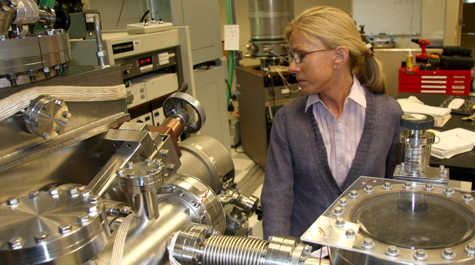W&M joins Virginia Nanoelectronics Center
Vanadium dioxide—or VO2—is an interesting substance with a number of intriguing properties, including its propensity to switch from an insulator to a conductor at moderate temperatures.
“One application that has been already thought for this material is to use it as a thermographic coating for windows,” Ale Lukaszew said. “Because if you have a material that becomes a conductor above some temperature, it means that it becomes like all metals—a reflector of light.”
VO2-coated windows become opaque and reflective when they get hot enough, keeping the sun and the heat out. “That’s a nice feature of this material,” she said, “but VO2 also has possibilities for less pedestrian applications.”
Lukaszew, William & Mary’s VMEC Professor of Physics and Applied Science, is leading a group studying VO2 and other materials that have interesting applications for nanoelectronics. The William & Mary group is part of a new industry-academia-government collaboration, the Virginia Nanoelectronics Center (ViNC). ViNC is based at the University of Virginia; the partnership also includes Old Dominion University.
ViNC was launched at a May 25 kickoff event in Charlottesville. Research at ViNC will serve as the foundation for producing faster, smaller and more affordable components in everything from mobile devices and computers to automobiles and energy-efficient homes.
“This is a fantastic example of the kind of R & D partnership that will help propel Virginia to the forefront of the innovation economy,” said Jim Duffey, Virginia’s secretary of technology.
ViNC will bring together world-class researchers to explore and develop advanced materials, novel devices and circuits at nanoscale dimensions. It will operate under the auspices of the U. Va. Institute for Nanoscale and Quantum Scientific and Technological Advanced Research, or nanoSTAR, based at U. Va. All three university partners have worked closely with Micron Technology, Inc., one of the world's leading providers of advanced semiconductor solutions with a memory chip manufacturing facility in Manassas, Va., to launch the new center.
“This new center is positioning Virginia at the heart of the development of a new nanoscale technology,” said Stuart Wolf, director of nanoSTAR and ViNC. “This center could establish the Commonwealth as the ‘oxide hills’ rather than a new ‘silicon valley.’”
Wolf will work closely with a number of co-principal investigators, including Lukaszew and her fellow VMEC Professors from U. Va. and ODU, Lloyd Harriott and Helmut Baumgart. The Commonwealth is supporting the new center through VMEC, the Virginia Microelectronics Consortium, a state-funded, industry-university consortium dedicated to the development of microelectronics in the state.
“Here at William & Mary, we can’t say enough good things about Stu Wolf,” said Dennis Manos, vice provost for research. “ ViNC is going to be a wonderful collaboration and Stu is the guy who put it all together.”
An important aspect of ViNC researchers’ work will be the discovery and development of materials for advanced information technologies. Scientists generally agree that the fundamental limits of the current microelectronics technology—known as complementary metal oxide semiconductor, or CMOS—will be reached in about a decade. ViNC will develop novel devices and circuits for “beyond CMOS” nanoelectronics. The center’s initial project is the development of information processing based on VO2 in place of traditional technologies. This approach offers the benefit of smaller size and faster processing at much lower power.
Lukaszew’s team at William & Mary will be based in a lab in Small Hall and will include physicists Irina Novikova, Eugeniy Mikhailov, Seth Aubin and Bill Cooke. The team is expecting delivery this summer of a titanium-sapphire laser amplifier for optical characterization studies of VO2 and other materials that show promise for nanotech applications.
Purchase of the instrument was made possible by support from the Nanoelectronics Research Initiative (NRI), one of three research program entities of the Semiconductor Research Corporation. NRI is funded by major semiconductor companies, Micron Technology, Intel, IBM, Texas Instruments and GLOBALFOUNDRIES, as well as the National Institute of Standards and Technology (NIST).
The center is being established with starting grants from NRI and VMEC and matching funds from the three participating universities, for a total of nearly $1.7 million over two years. The center’s projects are also funded by National Science Foundation and the Defense Advanced Research Projects Agency.















